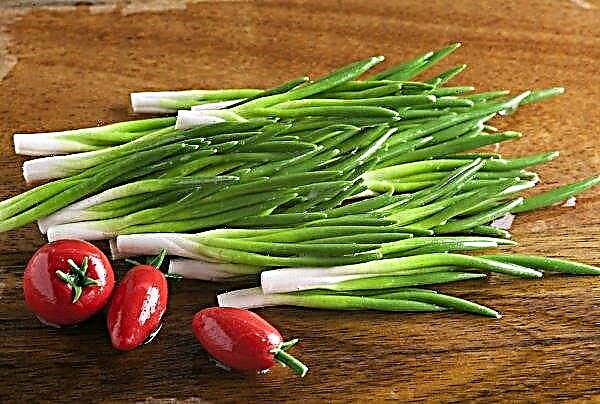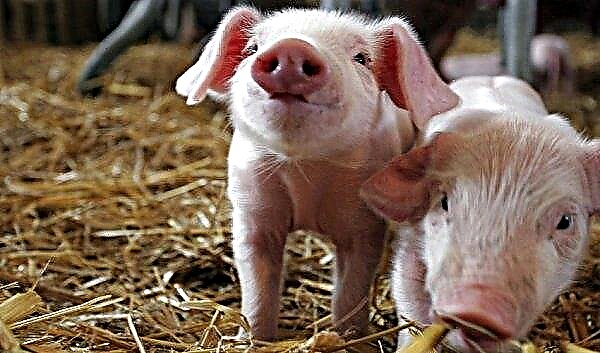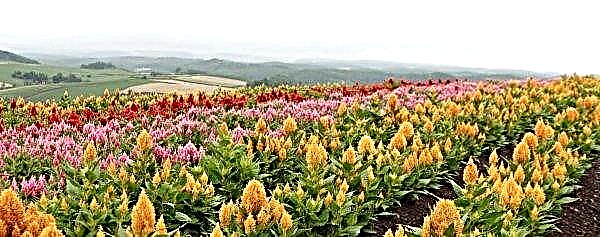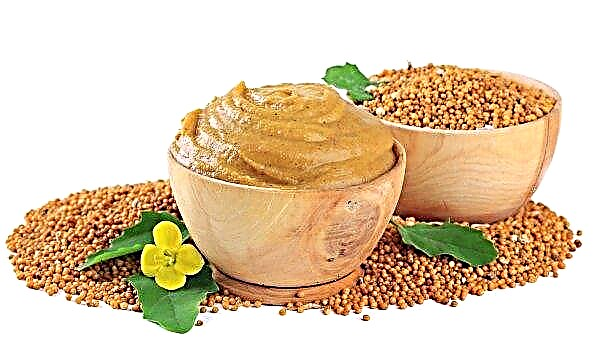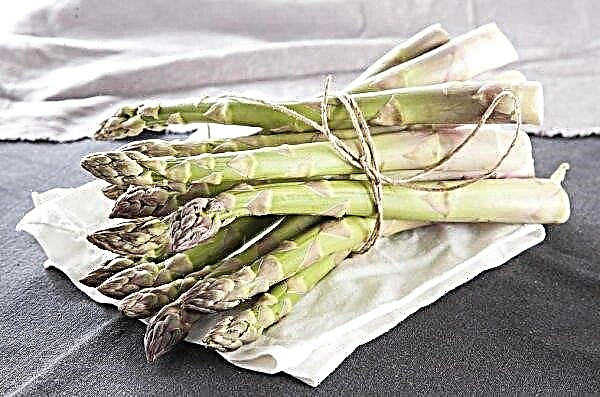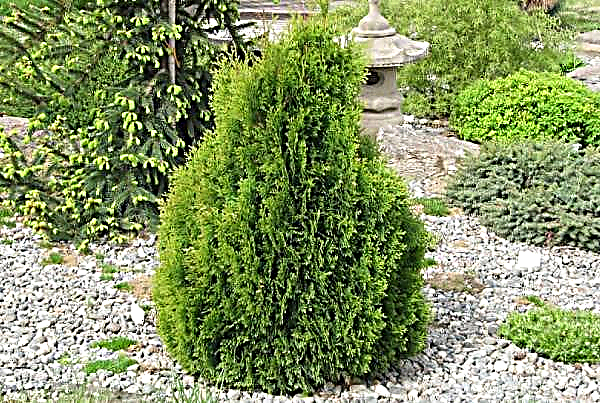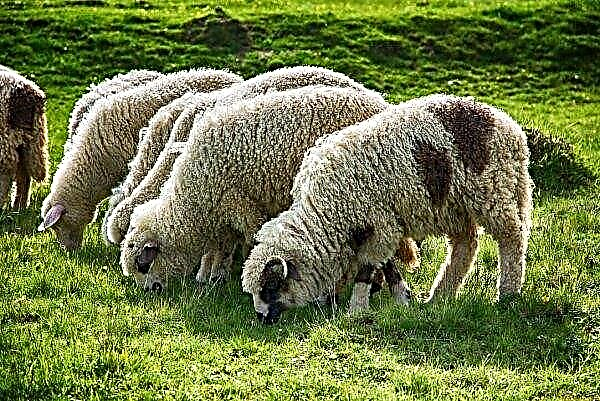Recently, greenhouses built from polypropylene pipes are beginning to enjoy great popularity. This is understandable, because most gardeners are looking for cheap and easy ways to grow garden crops. Today you will learn how to use water pipes to build a greenhouse on your site.
Did you know? Of all types of plastic, polypropylene is the second largest in the world in terms of production.
Pros and cons of polypropylene pipes for the greenhouse
- A greenhouse made using pipes made of polypropylene has the following advantages:
- lack of installation difficulties;
- low weight of the structure;
- the ability to experiment with the shape and size of the greenhouse;
- a significant reduction in financial, time and labor costs for installation;
- mobility of the structure, the ability to easily rearrange it to another section without disassembling;
- durability;
- low exposure to environmental factors;
- lack of need to periodically tint, grease or perform other work to bring the greenhouse into proper shape and working condition;
- the ability to serve as a decoration of the site due to the accuracy and attractiveness of the structure;
- absence of harmful impurities emitted into the environment;
- you can heat water for irrigation;
- does not rust and does not rot.
- However, it is worth mentioning the disadvantages of such greenhouses:
- Due to their low weight, they can be carried away by a strong wind, especially if the greenhouse is large.
- A special tool is needed to connect the ends of the pipes - a soldering iron for polypropylene pipes.
How to build a greenhouse from polypropylene pipes with your own hands?
To build such a greenhouse will not be difficult even for a woman, as you can see on the basis of the recommendations below.
Sizing
There are no particular size restrictions, but it must be borne in mind that the larger its size, the higher the windage, that is, the ability to fly away from the wind. If you need a large greenhouse, you must provide options for weighting the structure in the corners. To grow several types of vegetables or other crops under normal conditions, 2 m in height, 2.5 m in width and 4–6 m in length is enough. In this case, the distance between 2 arches should not be more than 0.9 m (the heavier the material of the walls, the smaller the distance).
Site selection and preparation
In order to properly position the greenhouse on the site, it is necessary to take into account the following requirements for its location:
- openness, lack of shade from buildings or vegetation on the site;
- lack of roughness on the surface;
- if necessary, attach a greenhouse to the building, do this from the south side so that it does not fall into the shade;
- the best option is from east to west.
Did you know? The inventors of greenhouses are the ancient Romans, who came up with the idea to bring the planted plants overnight into a heated room.
To prepare a place for construction, you must:
- Level it - remove the protruding parts of the soil, fill in the pits, lay out a brick or timber (if the surface is tilted).
- Choose the type of foundation and build it. You can do without a foundation, but it increases the strength of the structure.
- Using the wooden pegs, pieces of reinforcement or a metal pipe 0.6–1 m long, mark the corners of the greenhouse, measuring the distance with a tape measure. They will serve as the basis and should be strictly perpendicular to the surface of the earth. The right rectangle will have opposite sides, as well as diagonals. Leave at least 40 cm above the surface.
- On the long sides, make marks of approximately 0.5 m and drive into the ground or fix pegs, reinforcement or pipes (the base of the frame) into the foundation, placing them opposite each other at right angles to the surface of the earth. The specific size of the interval depends on the weight of the material for the walls of the greenhouse - the larger it is, the smaller the interval should be.
- Put the same marks in the place where the door will be attached.

Step-by-step construction instructions
Regarding the construction of greenhouses from plastic pipes, the network has a lot of information from video bloggers.
The construction process includes:
- Foundation construction.
- Frame construction.
Foundation work
The lack of foundation will make the greenhouse more mobile - it will be easier to disassemble and move to another place. However, its presence will provide resistance to wind and thereby eliminate one of the disadvantages of such greenhouses.
The foundation may be:
- wooden;
- concrete.
The wooden foundation is constructed as follows:
- Prepare boards with a minimum thickness of 2.5 cm and a length equal to the length of the walls of the greenhouse.
- Saturate them with an antiseptic.
- Dig a hole about 25 cm deep along the future walls of the greenhouse.
- Line the bottom and walls with roofing material, leave about 10 cm above the surface.
- Pour crushed stone about 10 cm thick, tamp.
- Join the boards at right angles with the help of metal corners and self-tapping screws.
- Install the resulting rectangle in the pit, along its long sides, expose the frame base from pegs, reinforcement or pipes, as described in the preparatory work. Do not forget about the door. Verify the installation using the level.
- Fill the empty places in the pit with rubble, tamp.

The concrete foundation is constructed as follows:
- Dig a hole 30–40 cm deep along the future walls of the greenhouse.
- Line the bottom and walls with roofing material, leave about 10 cm above the surface.
- Pour sand up to 10 cm thick, tamp.
- Pour crushed stone with a thickness of about 15 cm, tamp.
- For insulation, you can lay out a foam layer up to 5 cm thick.
- Install the frame base along the long sides, as described in the preparatory process. Mark where the doors will be.
- Make formwork from boards 20 cm above the surface of the earth.
- Install the frame base in the corners and along the walls, as described in the preparatory work.
- Since the design is quite light, you can do without an armored belt. Pour in concrete.
Important! Check that the base of the frame remains in a position perpendicular to the surface of the earth.
Creating a frame from polypropylene pipes
If the foundation is not provided, then pipes are laid along the walls of the greenhouse:
- They are laid not only along the walls, but also across them, so that the structure is rigid and retains its shape.
- In the corners they are connected using special corners.
- In those places where arches and a door will be attached, special tees are welded to the base.

Mounting and fixing the frame to the foundation
In order to install the frame, you need to carry out such actions:
- Measure the length of the arch, taking into account the height of the greenhouse, and cut the necessary lengths from the pipe.
- Bend the segments slightly to make them easier to install. Put one end on the base of the frame made of reinforcement, metal pipe, wooden peg or attach to the tee. Attach the other end to the opposite side. Install all arches.
- For fastening to the foundation, use metal plates and self-tapping screws, to the armature - metal wire.
- Cut a piece of pipe equal to the length of the greenhouse - this will be the top, ridge pipe. Attach it in the center of the arches with plastic clamps. Some propose to weld tees to the ridge pipe and fasten half the arches to it with tees.
- Cut 2 more of these pieces and attach them at a height of 90 cm from the ground level parallel to it. These beams are also designed to strengthen the structure.
- Equip the doorway. Install 2 pieces of the required height on the frame base at a distance of 0.7–0.9 m from each other or attach them using tees to the polypropylene base. Connect the upper ends with a segment using special angles.
- Make the door. To do this, you will need 2 long pieces arranged vertically and 3 short pieces arranged horizontally, the dimensions are 1 cm smaller than the size of the pieces for the opening. In short pieces, connect the upper and lower ends of the vertical pipes, as well as the middle with the help of corners and tees.
- Install the hinges and latch.
- The window opening and the window are installed similarly to the doors opposite them.
- If the greenhouse is long, for strength, you can install several uprights and attach them to the ridge pipe.
Important! Polypropylene pipes are the cheapest, flexible and least labor-intensive during installation.
Frame cladding
For sheathing the frame, you can use the following materials:
- Glass. The material is quite heavy, requires a rectangular frame, it is not recommended for this type of greenhouse.
- Agrofibre with a density of 30, 42 or 60 g / m² of white color. Unlike other materials, it allows air to pass through, so there is no need to equip a window, condensation is not collected inside, an optimal climate is formed. For fastening, it is necessary to sew pockets with the help of a sewing machine into which arches are inserted. A knot is tied at the bottom, the fiber is attached to the foundation. It is also attached to arches using clothespins or paper clips.
- Polyethylene film. The cheapest, but not the most durable option. It is attached to the foundation with the help of wooden battens or pipes and self-tapping screws, to the arches with special brackets. In this case, you can make the distance between the arches larger and dispense with uprights.
- Polycarbonate It is fastened with thermowells, it must be sealed with aluminum tape and a thermal tape, it is durable, lightweight, resistant to weather changes, but expensive and relatively heavy material. For installation, it is cut along the channels with a special jigsaw and mounted outward on the side on which there is a marking. Since the material is able to deform in response to a change in temperature, you can not put the sheets tightly in the joint, tighten the screws tightly, and the holes for them should be slightly larger than the required diameter. In such greenhouses, it is necessary to reduce the distance between the arches and install vertical racks.

Useful tips for choosing polypropylene pipes
When choosing pipes, first of all, you need to pay attention to the material from which they were made. There are such plastic pipes:
- From polyvinyl chloride - such products are non-combustible, lightweight, resistant to ultraviolet rays and low temperature, the type of connection is bonding.
- Made of polypropylene - they are well bent, durable, resistant to low and high temperatures, the type of connection is welding or soldering.
- Made of polyethylene - polyethylene pipes of high pressure (LDPE) or low pressure (HDPE). The products are flexible, but at temperatures below + 50 ° C they lose flexibility, poorly tolerate high temperature, and are sensitive to ultraviolet rays. Type of connection - welding.
- Made of cross-linked polyethylene - have improved characteristics compared to previous ones, type of connection - crimp metal couplings.
- From metal - they bend well, have an attractive appearance, do not deform when exposed to high and low temperatures, the type of connection is fittings.
- From polybutylene - bend well, do not lose elasticity when exposed to high and low temperatures, are sensitive to ultraviolet rays, the type of connection is fittings.
Pipes for the construction of greenhouses should have the following characteristics:
- inner diameter - not less than 16 mm;
- optimal wall thickness - 4.2 mm or more;
- lack of cracks and other damages;
 A greenhouse with a height of 2 m, a width of 2.5 m and a length of 4 m will require about 60 m of pipes. So, the use of polypropylene pipes for the construction of greenhouses allows you to reduce the cost of the design, make it light and mobile. As a material for their sheathing, you can use a film, agrofibre or polycarbonate.
A greenhouse with a height of 2 m, a width of 2.5 m and a length of 4 m will require about 60 m of pipes. So, the use of polypropylene pipes for the construction of greenhouses allows you to reduce the cost of the design, make it light and mobile. As a material for their sheathing, you can use a film, agrofibre or polycarbonate.

